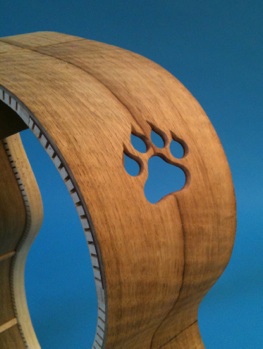Design Philosophy 8

The Sound Port
Wednesday, August 7, 2013
These days, sound ports are showing up on custom-made acoustic guitars like mushrooms after a drenching rain. I’m beginning to think that the only people who don’t believe in the sound port are those who haven’t yet given it an honest try, out of obedience to tradition or whatever.
Just a few years ago, I recall that there was a lot of debate and controversy about the idea. Some people thought that sound ports were a form of quackery, while others were fervent believers. Conversations ensued on online guitar forums, and in the highly respected trade journals of the Guild of American Luthiers and the Association of Stringed Instrument Artisans both featured articles delving into this innovative idea. A number of prominent luthiers devised ways to test the efficacy of sound ports.
The most illuminating information I ran across was an article on Tim McKnight’s excellent website, in which Tim performs controlled experiments to objectively determine the sonic effects of sound ports on acoustic guitars. Go HERE to check out this fascinating, lavishly illustrated article. And while you’re there, spend a little time exploring the rest of the McKnight Guitar website. Tim is one of my most admired personages in Modern Lutherie; get to know him and Mary, his wife and business partner, and you’ll see why.
In the midst of all the controversy about ported guitars, I decided to make one myself, and draw my own conclusions. I decided the best way to do this was to make a sound port with a sliding hatch that would open or close the port. If it turned out not to make any difference, it would be a lot of extra work for nothing; but at least I could base my opinion directly on experience, not hearsay.
My first ported guitar was also the first prototype Consort Venetian I built. It turned out rather well, and it irrevocably made me a believer in the whole sound port concept. Check out this YouTube video of this guitar, played by Aaron Stang: https://www.youtube.com/watch?v=nsOqt4SilK8

I had plenty of other people try out the guitar also. Every person, bar none, expressed the same impressions as mine. Port closed, very good. Port open, WOW!
And when I listened from the audience perspective, I noticed some interesting effects as well. I could stand behind the person playing the guitar, and it sounded almost as loud as it did in front. With the port open, the guitar seemed to have some organic reverb added; it also seemed louder overall than with the slider shut.
At this point, I couldn’t understand why there had ever been any controversy about it. During the year or so that the guitar was still mine, the sound port stayed open about 90% of the time.
I also tried some basic recording tests on it. Using two AKG C1000 condenser mics, plugged into a Tascam four-track cassette recorder, I tried various microphone placements. I recorded totally flat, no effects or signal processing. With one mic over my left shoulder, pointing at the sound port, and the other in front of the soundhole at about the six o’clock position, I got a distinct reverb effect. The guitar sounded airy and spacious. This led me to believe that ported guitars also offer some interesting options for sound shaping, when recording with microphones.
Ever since I built that first ported guitar, I’ve included side sound ports on the vast majority of my six-string progeny. People have come to expect them. Most of them are open, bound ports on the upper bout, driver’s side. I still make ports with sliders too, because they are efficacious for recording, and because some people like the variations in tone and projection. A couple of people have told me they like playing rhythm with a flatpick with the port closed; and then open it for fingerstyle playing.

The internal track is very carefully constructed so that there is no slop in the fit; and the tracks are lined with felt, so there should never be any extraneous noises.
In the early version pictured here, I used felt-lined rosewood for the tracks. These days, I use felt-lined
.060 black fiber material. The slider action is snug, but nice and smooth. If it gets sticky, I just remove the slider hatch, rub a little Johnson Paste Wax on the edges, and reinstall. Takes about five minutes.


I have also done custom designs, with artfully chamfered edges. Here’s the canine footprint on a Black Limba Zephyr. The photo doesn’t show it, but there are red and black veneer lines accenting the underside of the paw print.
In 2013, at the behest of Vincent G., one of my custom-build clients, I built a Falcon guitar with a new design I call the Tri-port. This sound port design consists of three chamfered openings on the lower bout hip of the guitar.
My immediate reaction to this new iteration of the sound port was that this is a VERY effective placement for sound ports. Below are photos of this new design on two 2013 guitars.
Since around the turn of the 21st century, auxiliary side sound ports have been turning up on more and more high end, custom made guitars. The idea is, having a sound port on the side of an acoustic guitar will direct more sound to the player, hopefully enhancing the overall musical experience.
There has been plenty of debate about whether the side sound port actually works; but the more people who experience them, the more the affirmative consensus grows. I am a firm believer in the sound port. In my opinion, the sound port is NOT a gimmick. It is an advance in the state of the art of acoustic guitar design.






